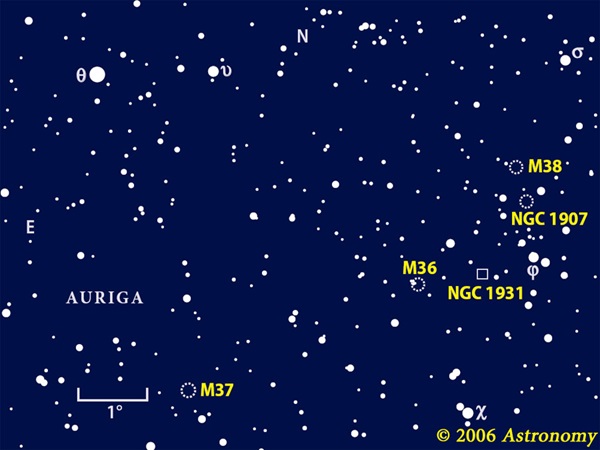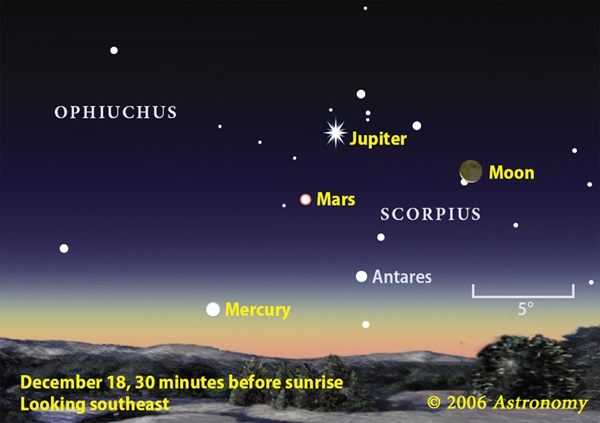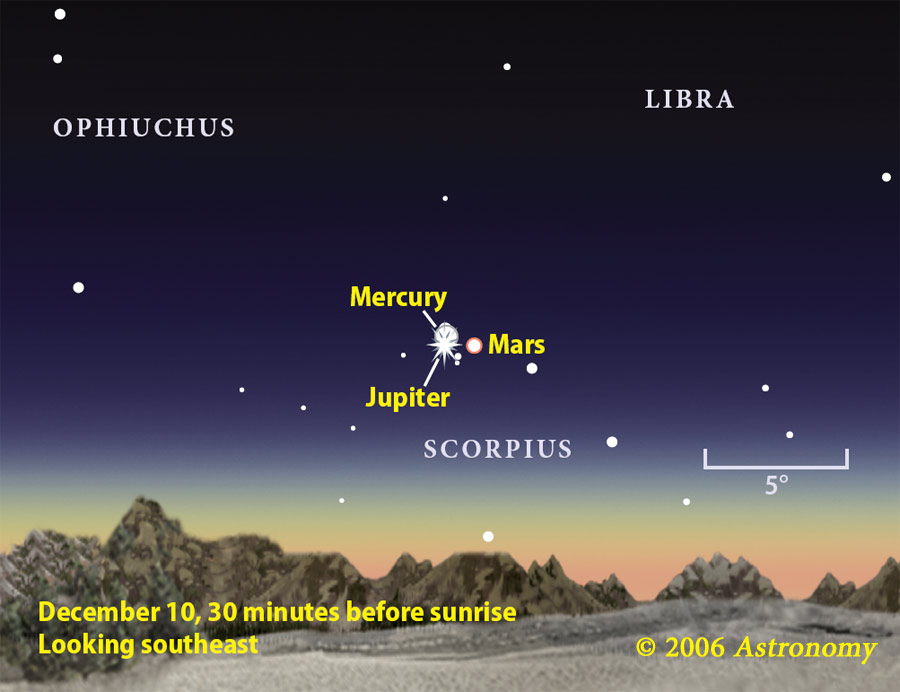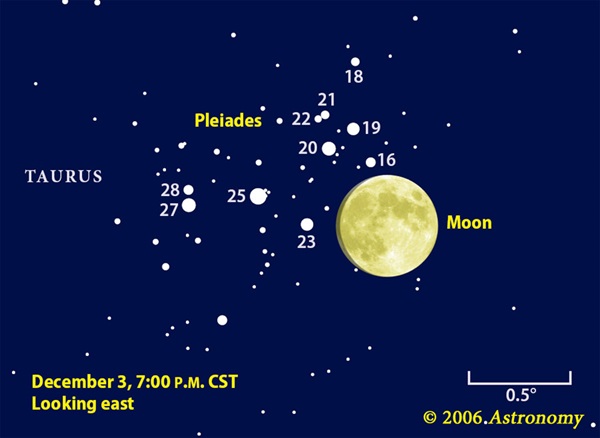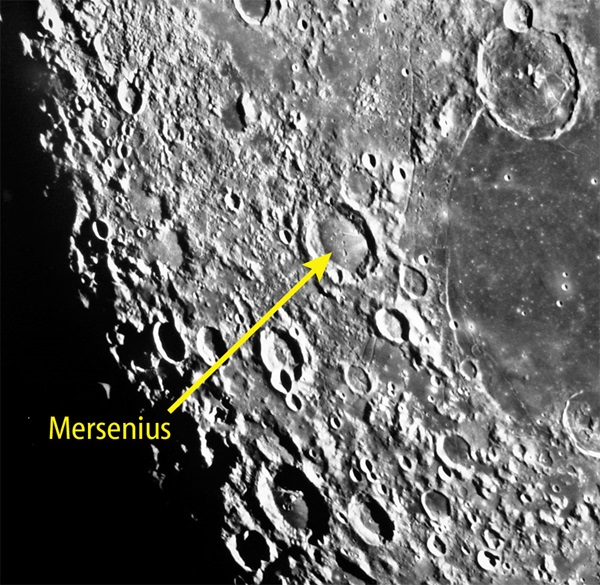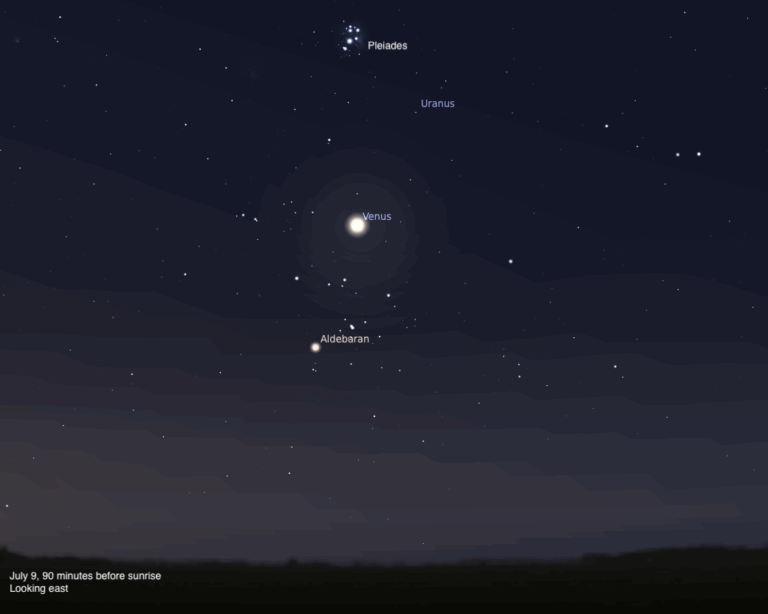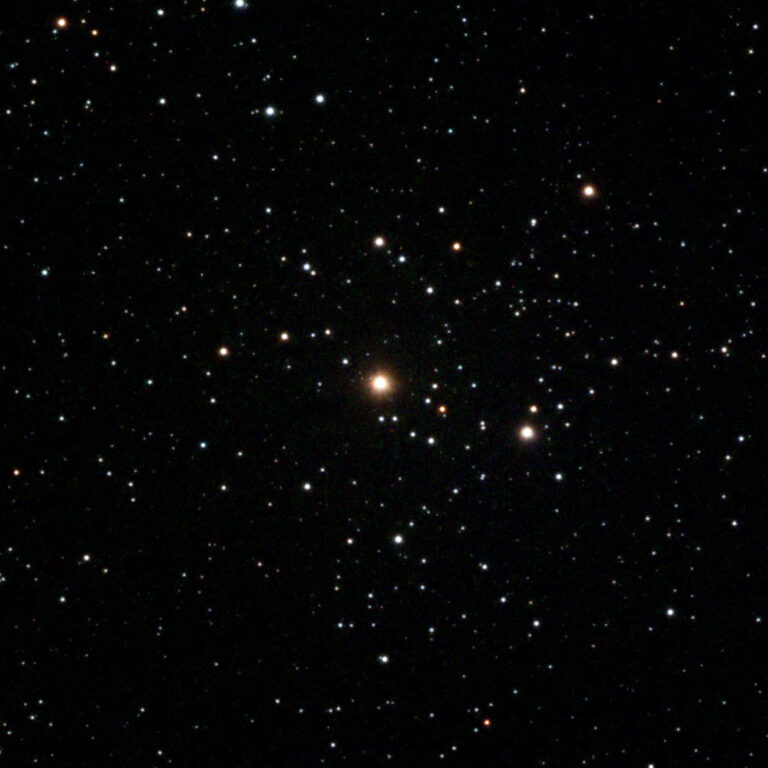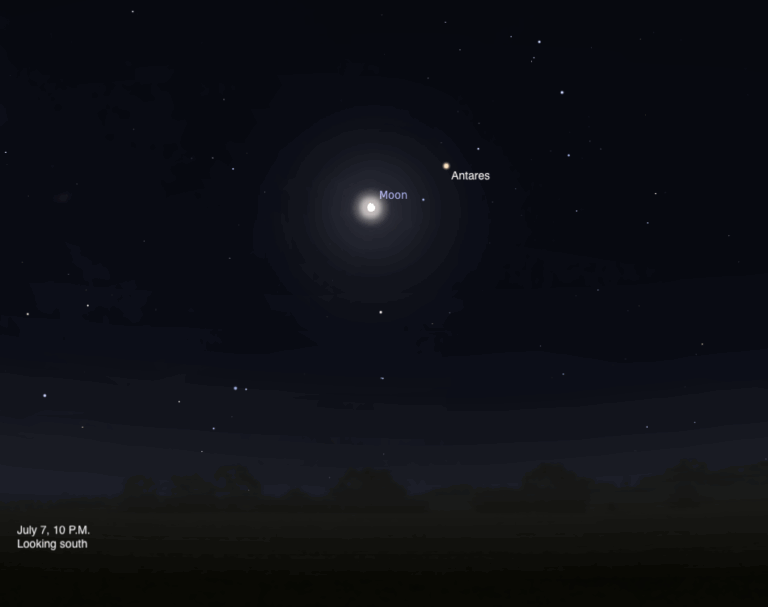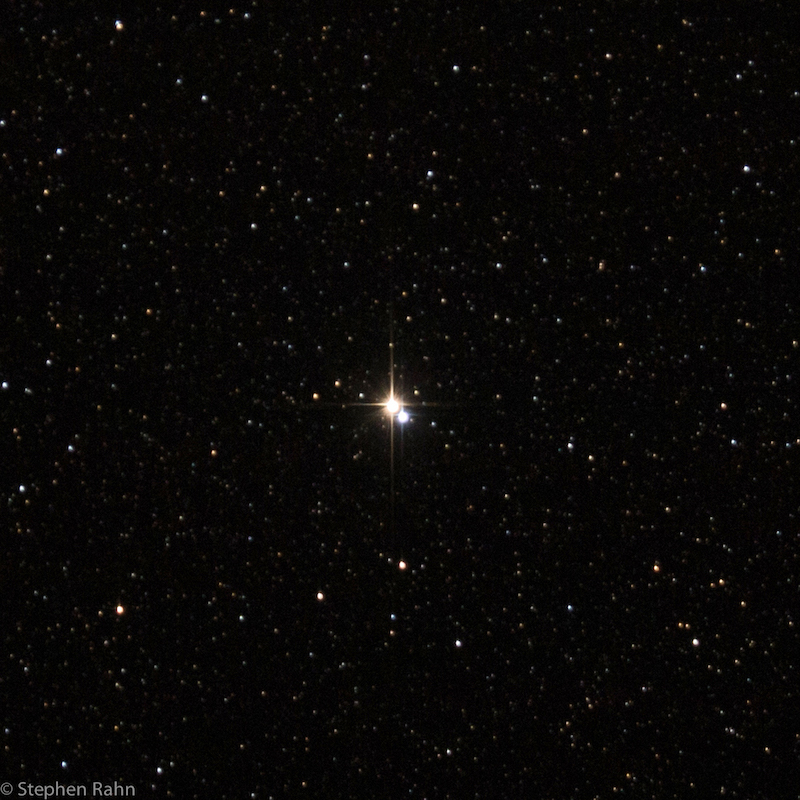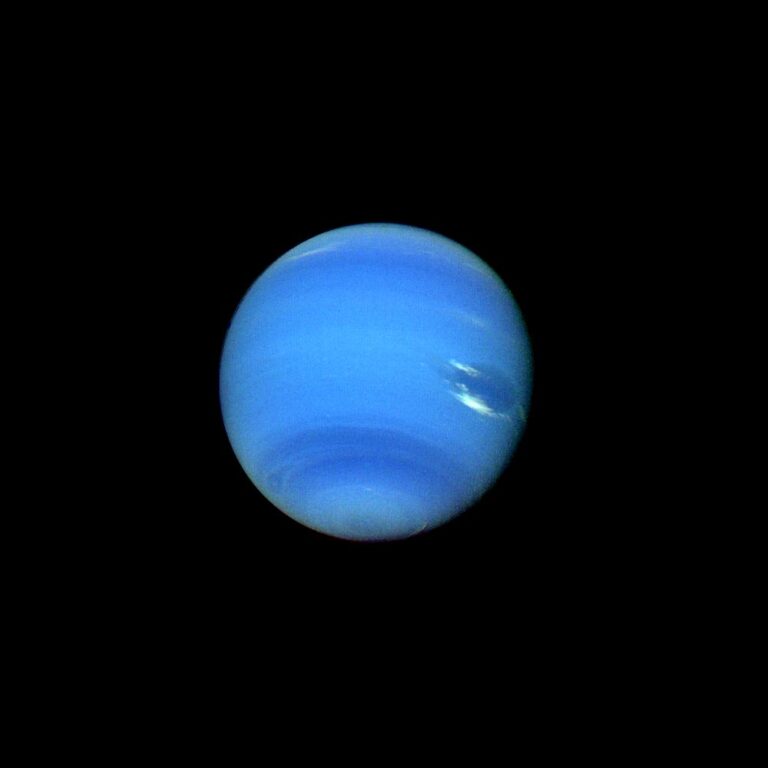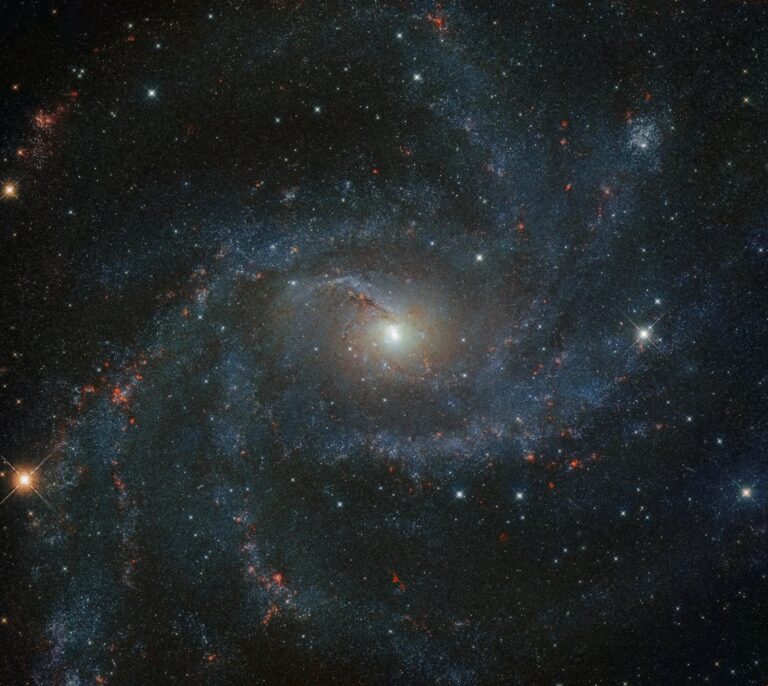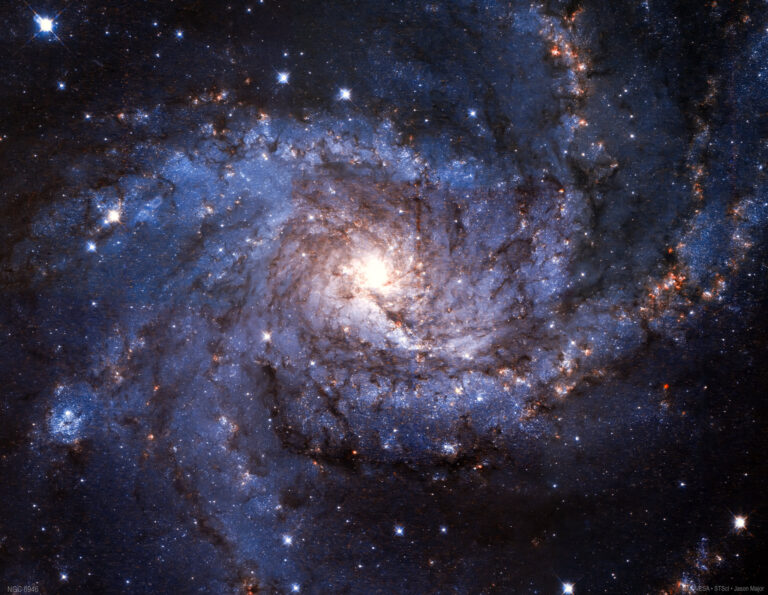Key Takeaways:
Early risers receive a wonderful bonus when the giant planet Jupiter soars past sinking Mercury. By December 7, blazing Jupiter should be easy to spot as long as you have an unobstructed southeastern horizon. Make sure you take a look through binoculars you’ll find Mars hiding between the pair. Far from its glory at opposition, Mars lies on the far side of the Sun from Earth and glows feebly, two full magnitudes fainter than Mercury.
Closest approach for the two bright planets comes the morning of December 10 at about noon EST, when Mercury skims just 8′, one-quarter the Moon’s apparent diameter, past Jupiter. If your telescope can track, follow the pair from dawn right through the day.
Ringed Saturn rises in the east before 10 p.m. by mid-December. It shines with a steady yellow glow compared with the twinkling stars commanding the southern sky. Unfortunately, turbulence in Earth’s atmosphere degrades Saturn’s image through a telescope when the planet lies close to the horizon. Your best views will come near dawn. Avoid looking over chimneys now that heating season is in full swing.
December means it’s Geminid time. Relatively slow but bright shooting stars are the trademarks of winter’s best meteor shower, which hits its peak the morning of the 14th.
If it weren’t for the cold, many observers would rank the Geminids ahead of August’s Perseids for oohs and aahs. Bundle up, and prepare to awake just before dawn, when rates are highest. Observing in the early evening, and especially from the city, will prove disappointing because half the meteors occur below the horizon, and another big chunk is lost behind the veil of light pollution. The waning crescent Moon will interfere some, but not enough to spoil the show. Many observers go with a group to a dark site — the experience can be a lot of fun.
The Moon covers the Pleiades star cluster (M45) twice this month. The first time comes the evening of December 3, although some guide books and calendars list it on the 4th, in Universal Time (UT). Astronomers use UT to avoid the confusion that arises from different time zones. It runs 5 hours ahead of EST.
Because the Moon appears just before full on the 3rd, stars will disappear behind a slim, dark limb. An hour or 2 later, they reappear against the Moon’s bright limb — a much tougher observation. You can find precise occultation times for many individual Pleiads from most cities on the web.
The Moon’s second Pleiades passage occurs the morning of December 31. It can be seen from North America’s West Coast (just before dawn), the Pacific Ocean, and eastern Asia.
Have you missed Venus recently? It’s been on the far side of the Sun from Earth, but it’s coming back to reclaim its title as the evening star. Just before New Year’s, Venus starts poking through the bright yellow sky shortly after sunset. Use binoculars to find it initially. In just a few days, however, it will be obvious to the unaided eye. It’s heading for a marvelous conjunction with the Pleiades in mid-April.
Although summer’s Sagittarius possesses many of the sky’s biggest and brightest deep-sky objects, winter’s Auriga has a sparkling vista unrivaled elsewhere. There’s no better way to view this magnificent region than through binoculars. You can find Auriga’s stretched pentagon shape climbing in the northeast as darkness falls. It’s suspended under the twinkling yellow luminary Capella.
Binoculars provide just the right magnification to show fields overflowing with bright stars immersed in a faint but rich Milky Way background. As many of you know, a dark sky away from light pollution and moonlight will give you the best return for your effort.
Three bright star clusters jump out from the hundreds of faint background stars. Smack in the center of Auriga’s pentagon lies Messier number 38. Steadily held binoculars capture the brighter pinpoints of this celestial star-city. In the same field, the brighter cluster M36 probably has caught your attention as well. If you shift your sight 4° more to the east — still in the same field as M36 — the softer glow of M37 betrays its presence. If you lose your way, try aiming halfway between Theta (θ) Aurigae and Beta (β) Tauri, then ease a bit east. Sky directions can be confusing. Remember, from the Northern Hemisphere in mid-evening, east in Auriga means to the lower left.
Use a telescope to uncover the different faces of these three star clusters. M37 contains the faintest stars, and they’re all nearly identical except for the central orange-hued luminary. M36 holds mostly bright stars, with some decked out in pairs. In contrast, M38 has stars that run the gamut of magnitudes. If you have a 6-inch or bigger scope, check out M38’s nice companion cluster, NGC 1907, just south of M38.
A few lucky amateur astronomers have discovered comets accidentally while searching for deep-sky objects. Tucked among the star clusters in Auriga lurks a comet look-alike that has startled more backyard observers than any other. Unlike galaxies and faint star clusters, the combination emission and reflection nebula NGC 1931 makes a good fake through a small scope operating at low power.
The masquerade begins with a bright, diffuse head, and enchants us further with a fan-shape tail of nebulosity — just like many comets. But the excitement soon dies. Comets drift during a night’s observing session, while background objects remain fixed.
A nebula filter does not enhance NGC 1931 because its glow comes mainly from scattered starlight and not fluorescence. As a result, you’ll have a tough time enjoying the view from a city, if you’re able to find NGC 1931 at all.
Venus returns to the evening sky in late December, and Uranus remains an easy binocular object after dusk. Saturn joins the parade later in the evening, when it rises in the east. But the month’s best planetary event occurs in the predawn sky: Jupiter, Mars, and Mercury lie within a 1° patch of sky December 10. Those lucky enough to have 3 or more clear mornings in a row will be able to watch the trio’s rapidly changing appearance.
You’ll have a hard time tracking down Venus in early December, but by month’s end, it appears clearly after sunset. On December 18, the brilliant planet stands a mere 3° above the southwestern horizon 30 minutes after sunset. By the end of the year, it rises to 6°.
Venus now lies on the far side of the Sun from Earth. As a result, telescopic views show a fully illuminated disk that spans a meager 10″. As the planet’s orbit carries it closer to Earth over the next several months, you’ll be able to see Venus’ disk increase in apparent size while the illuminated portion shrinks.
By late evening, you can find Saturn climbing in the east among the stars of Leo the Lion. On December 9, a waning gibbous Moon rises with Saturn around 10 p.m. local time. A mere 3° separate the two solar system objects. During the morning hours, this distance shrinks to just 1°. Regulus, Leo’s 1st-magnitude luminary, lies 5° from Saturn.
The ringed planet begins its retrograde loop December 6. On this date, it starts moving westward relative to the background stars. It approaches within 4.8° of Regulus on the 6th and then starts creeping away during the rest of the month. This retrograde motion means Earth, in its faster, inner orbit around the Sun, has started to overtake Saturn. It foretells the planet’s upcoming opposition in February.
The best views of Saturn through a telescope will come well after midnight, once the planet has climbed far above the horizon. At December’s close, the ringed planet stands 35° high in the east by midnight local time.
Saturn’s magnificent rings span 43″ through their long axis and 9″ through their short axis. With the minor axis now slightly less than half the 19″ diameter of Saturn’s globe, details in Saturn’s atmosphere should be easier to view than they have been the past few years. Still, these atmospheric features remain subtle at best.
Saturn’s brightest moons offer a range of challenges for backyard observers. Titan, the ringed planet’s biggest moon, is also its brightest, glowing at magnitude 8.4. It’s easy to spot through any size telescope. As the moon’s light falls on your retina, remember this is the most distant object on which humans have landed a spacecraft (the Huygens probe in January 2005). Titan completes one orbit of Saturn every 16 days. You can find it due north of Saturn the mornings of December 3 and 19, and due south of the planet the mornings of December 11 and 27.
Iapetus lies at the fainter extreme. It also varies in brightness, appearing 5 times brighter when farthest west of Saturn than when farthest east. Iapetus reaches greatest eastern elongation December 18, and its 11.9-magnitude glow will be tough to pick up.
Although Saturn’s other bright moons won’t be as hard to see, they do hover like fireflies close to Saturn’s brilliant glare. The three easiest inner moons to locate are Tethys (magnitude 10.3), Dione (10.4), and Rhea (9.7). You’ll need superb conditions to spot 12th-magnitude Enceladus and 13th-magnitude Mimas
During the following week, Mercury sinks in the predawn sky while dim Mars and brilliant Jupiter climb higher, setting up a grand meeting against the background stars
of Scorpius. On December 9, the three planets form a neat triangle in the twilight 45 minutes before sunrise. Mercury then stands 1.5° west of Jupiter and 1° north of Mars.
The following morning, Mercury and Jupiter lie just 17′ apart and appear in the same telescopic field of view. The pair sits just below Beta (β) Scorpii, a 2.5-magnitude double star that will be difficult to see in the twilight, and 1° to Mars’ left. This marks the closest conjunction of three naked-eye planets during the first half of the 21st century.
On December 11, Mercury scoots a degree below Jupiter, and the two form another triangle with Mars. Only 48′ separate Mars and Jupiter. With each day, Jupiter gains altitude in the morning sky and becomes easier to see, while Mercury falls and becomes more difficult to spot.
The morning of December 18 finds a slim crescent Moon 7° to the right of Jupiter, and Mercury 10° to the lower left of Jupiter. Mars then lies about halfway between these two planets. Look carefully, and you should see 1st-magnitude Antares, the brightest star in Scorpius, 4° to Mars’ lower right. The ruddy star’s light should closely match the Red Planet, which shines half a magnitude fainter.
A similar occultation occurs December 31 for those living along the Pacific Rim. You can find precise occultation times for many cities on the International Occultation Timing Association’s web site.
The Sun reaches its farthest point south in our sky this month. Winter in the Northern Hemisphere officially begins December 21 at 7:22 p.m. EST.
A waning crescent Moon rises with the constellation Virgo between 1 a.m. and 2 a.m. local time. Although the Moon provides some interference, the stray light shouldn’t be more than a minor nuisance. Geminid meteors strike Earth’s atmosphere at 22 miles per second, modest by meteor standards, and tend to be bright. The Geminid shower compares favorably with August’s Perseids, particularly this year, when a nearly Full Moon hampered Perseid viewing. Possible cold temperatures remain the Geminids’ chief drawback. To enjoy Geminid observing to the fullest, dress warmly and bring along a hot beverage.
A second meteor shower peaks about a week later, on December 22, when the Moon doesn’t interfere at all. The Ursids don’t boast the same numbers as the Geminids; the former averages no more than 10 meteors per hour in a typical year. But occasional outbursts, which raise the rate to around 50 per hour, do occur. Ursid meteors are a tad slower than Geminids and tend to be faint.
The Ursid shower’s radiant lies in Ursa Minor, near the bright star Kochab (Beta [β] Ursae Minoris). This region is circumpolar from most of the Northern Hemisphere, so viewing can last all night. Like most meteor showers, however, rates improve after midnight.
Southwest of the Moon’s prominent crater Gassendi, on the western shore of Mare Humorum, lies the 52-mile-wide crater Mersenius. Through a small telescope, the lava-filled Mersenius shows a clearly defined rim. Several smaller craters pepper the main crater’s rim and attest to its great age. As the Sun rises over Mersenius, as it does both December 1 and 31, you should be able to see that the floor bulges upward. You also may notice a string of small craters pitting the floor. One thing you won’t see in Mersenius is a central mountain peak.
A long rille stretches along the eastern side of Mersenius and to its south. Most other nearby rilles appear to be concentric with the Humorum basin, but the Mersenius rille is not. This deviation hints at a different origin. Charles Wood, in his book The Modern Moon, suggests this rille runs radial to Oceanus Procellarum and may have formed in response to the giant impact that created this great basin.
Why should you be awake at 4 a.m. EST December 3 to watch? One reason is the asteroid disappears behind the Moon’s limb more gradually than the instantaneous vanishing act of a star. You can see for yourself if you live south of a line stretching from Washington State to North Carolina, because the Moon almost simultaneously occults the bright double star Epsilon (e) Arietis. Along this graze line, you’ll see many events as the star peeks through lunar valleys. Head to lunar-occultations.com/iota for details.
Epsilon Ari serves as a guidepost for tracking the slow nightly motion of 130-mile-wide Iris. It may take a few nights of binocular observing before you notice the asteroid’s movement (wait a few days until the Moon gets out of the way). By the way, a good 4-inch scope should be able to split this double star.
The components shine at magnitudes 5.2 and 5.5, with a tight, 1.5″ gap between them.
Because Comet 4P/Faye swings no closer to the Sun than the orbit of Mars, it rarely gets brighter than 8th magnitude. Unlike this past spring’s Comet 73P/Schwassmann-Wachmann 3, which was full of surprises as it broke into dozens of pieces, Faye should behave like a typical dirty snowball. The inner part of Faye’s orbit lies close to Mars’, and the two objects share similar characteristics as they move across the sky.
Faye reached opposition in late October, so it now appears in the southeast once the sky grows dark. It travels more slowly than Earth, but doesn’t fall behind that quickly. This means it will hang around for a few more months, moving eastward against the background stars.
You can find Faye in Cetus, to the west of Aldebaran (right, as seen from the Northern Hemisphere). The celestial whale is not an easy constellation for newcomers to picture. Try anchoring yourself to the three brighter stars of the tail and working from there. Not far from Delta (δ) Ceti, you’ll find M77, the nearest Seyfert galaxy to us. The main difference between a normal galaxy like the Milky Way and a Seyfert is that the supermassive black hole at the Seyfert’s center actively swallows material, and the accretion disk that forms around this black hole emits lots of energy. Comet Faye should appear about a magnitude fainter than M77.
A waxing gibbous Moon passes near Faye December 29 and will try to cast a shroud over an interesting event. The comet then passes in front of the bright double star Gamma (γ) Ceti, whose components shine at magnitudes 3.5 and 7.3 and lie a fairly tight 2.8″ apart. Will Faye’s sunlit dust cocoon completely hide the stars, or will they look like extra false nuclei?



